Effective Workplace Culture Framework in Nursing Care Development
VerifiedAdded on 2023/03/29
|10
|2301
|419
Essay
AI Summary
This essay explores the application of an effective workplace culture framework within the context of nursing care. It begins by examining key themes such as preparation, planning, and the development of trusting relationships between nurses and patients, analyzing them through the lens of the framework's attributes, enabling factors, and consequences. The essay emphasizes the importance of a person-centered approach, open communication, lifelong learning, and teamwork in fostering a positive healthcare environment. Furthermore, the essay delves into recommendations for improving the caring culture, including the adoption of technological advancements, transformational leadership, open-door policies, person-centered care initiatives, team-building activities, and staff empowerment strategies. The essay concludes by highlighting the significance of a dynamic workplace culture that prioritizes the needs of both patients and staff, thereby contributing to the achievement of hospital goals and objectives.
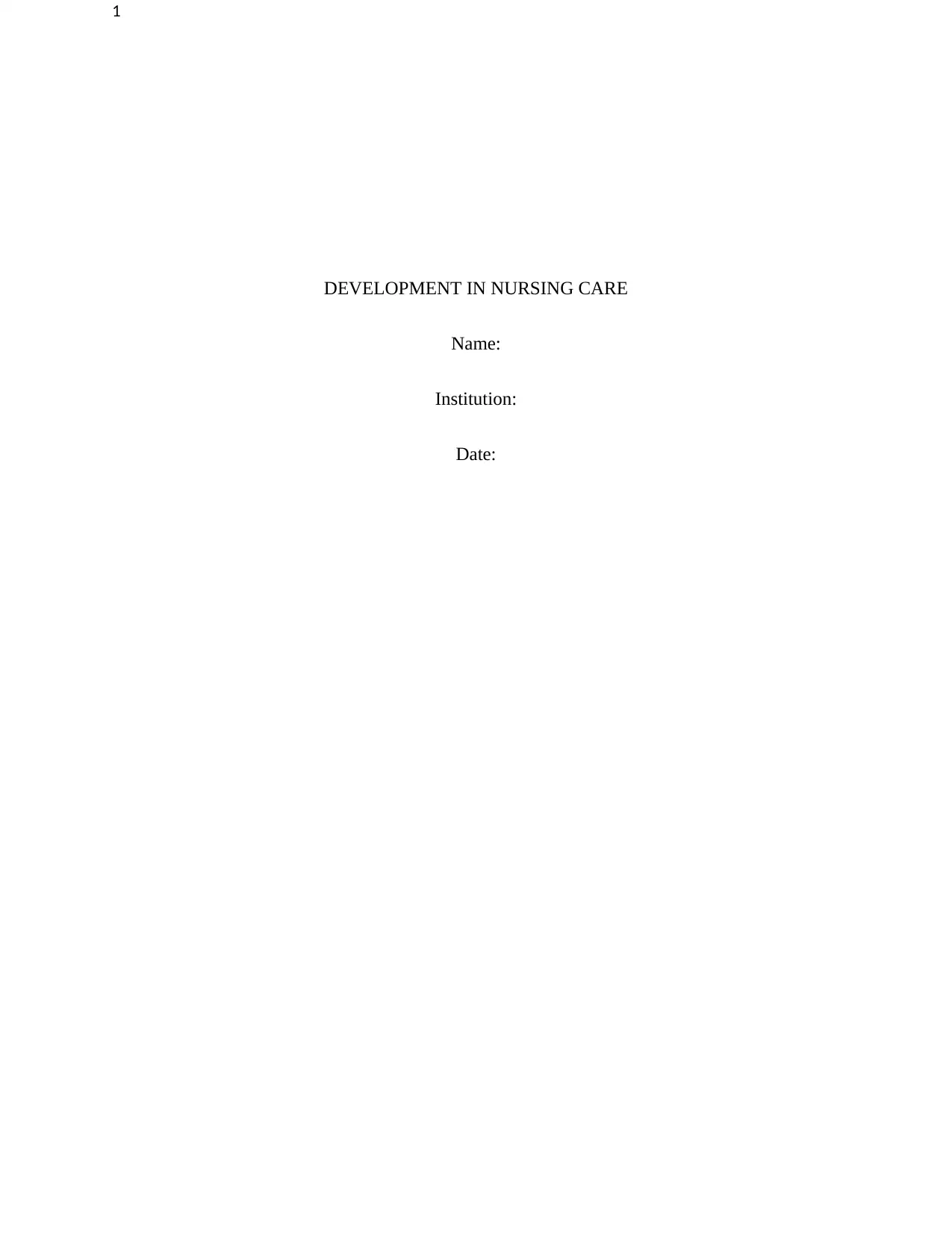
1
DEVELOPMENT IN NURSING CARE
Name:
Institution:
Date:
DEVELOPMENT IN NURSING CARE
Name:
Institution:
Date:
Paraphrase This Document
Need a fresh take? Get an instant paraphrase of this document with our AI Paraphraser
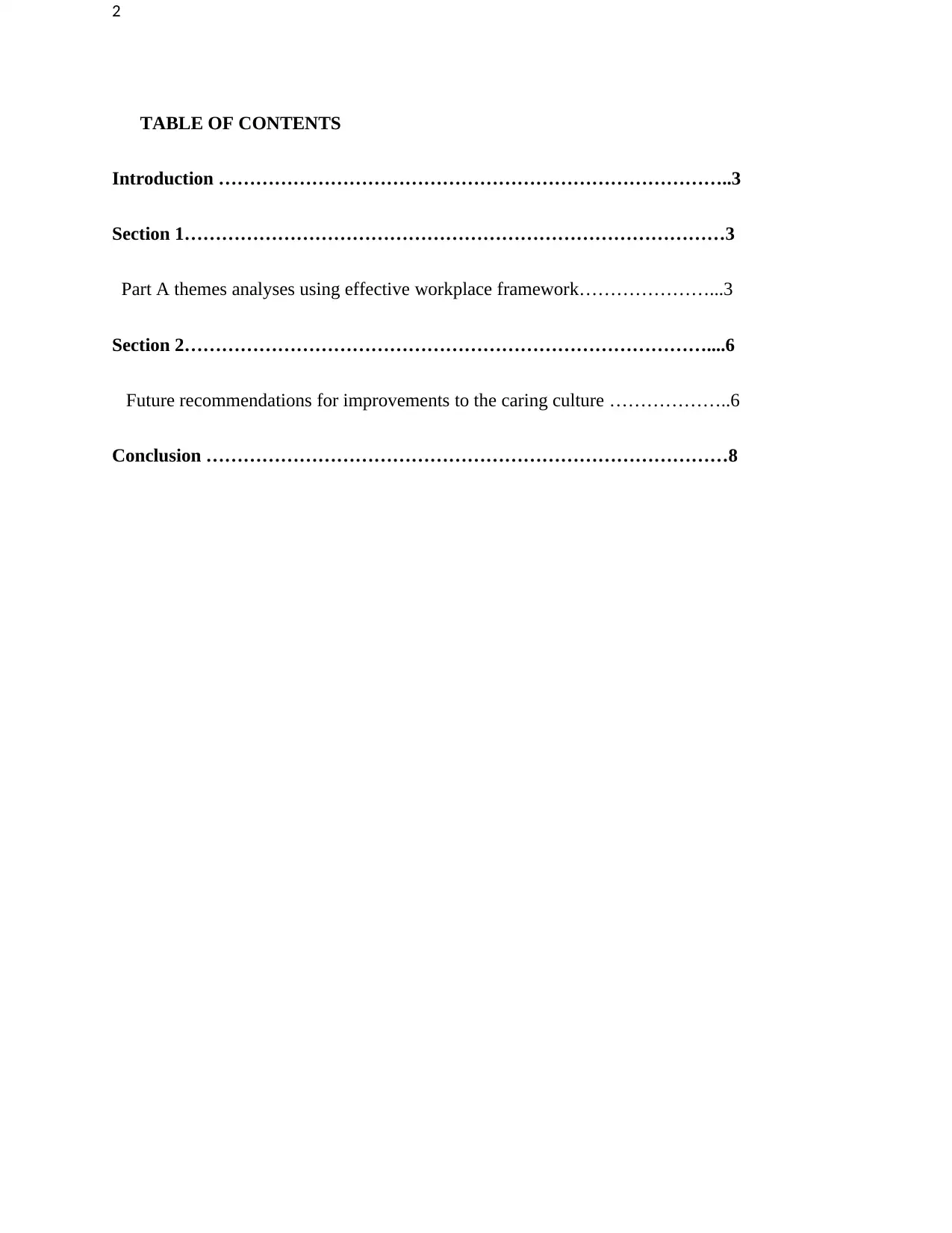
2
TABLE OF CONTENTS
Introduction ………………………………………………………………………..3
Section 1……………………………………………………………………………3
Part A themes analyses using effective workplace framework…………………...3
Section 2…………………………………………………………………………....6
Future recommendations for improvements to the caring culture ………………..6
Conclusion …………………………………………………………………………8
TABLE OF CONTENTS
Introduction ………………………………………………………………………..3
Section 1……………………………………………………………………………3
Part A themes analyses using effective workplace framework…………………...3
Section 2…………………………………………………………………………....6
Future recommendations for improvements to the caring culture ………………..6
Conclusion …………………………………………………………………………8
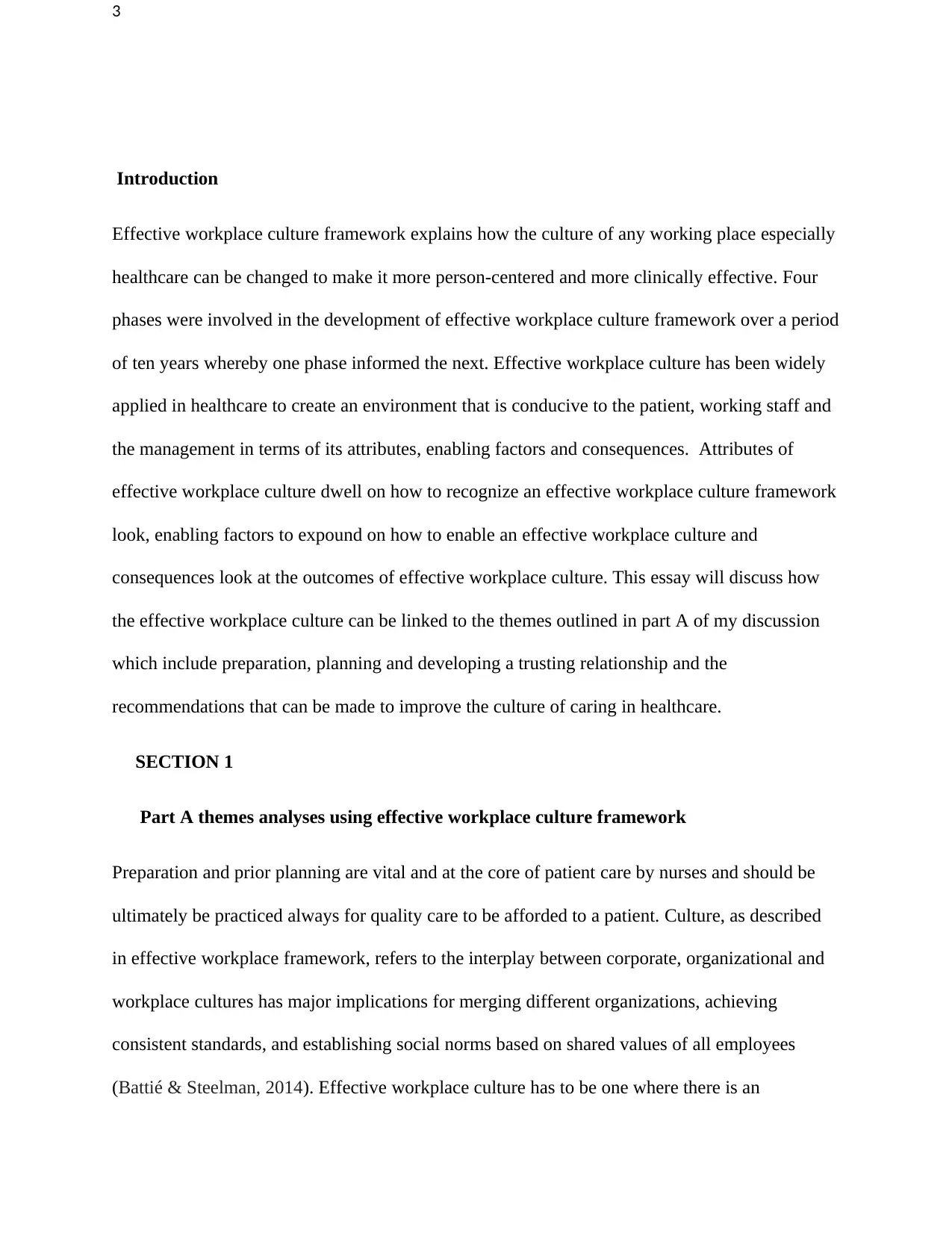
3
Introduction
Effective workplace culture framework explains how the culture of any working place especially
healthcare can be changed to make it more person-centered and more clinically effective. Four
phases were involved in the development of effective workplace culture framework over a period
of ten years whereby one phase informed the next. Effective workplace culture has been widely
applied in healthcare to create an environment that is conducive to the patient, working staff and
the management in terms of its attributes, enabling factors and consequences. Attributes of
effective workplace culture dwell on how to recognize an effective workplace culture framework
look, enabling factors to expound on how to enable an effective workplace culture and
consequences look at the outcomes of effective workplace culture. This essay will discuss how
the effective workplace culture can be linked to the themes outlined in part A of my discussion
which include preparation, planning and developing a trusting relationship and the
recommendations that can be made to improve the culture of caring in healthcare.
SECTION 1
Part A themes analyses using effective workplace culture framework
Preparation and prior planning are vital and at the core of patient care by nurses and should be
ultimately be practiced always for quality care to be afforded to a patient. Culture, as described
in effective workplace framework, refers to the interplay between corporate, organizational and
workplace cultures has major implications for merging different organizations, achieving
consistent standards, and establishing social norms based on shared values of all employees
(Battié & Steelman, 2014). Effective workplace culture has to be one where there is an
Introduction
Effective workplace culture framework explains how the culture of any working place especially
healthcare can be changed to make it more person-centered and more clinically effective. Four
phases were involved in the development of effective workplace culture framework over a period
of ten years whereby one phase informed the next. Effective workplace culture has been widely
applied in healthcare to create an environment that is conducive to the patient, working staff and
the management in terms of its attributes, enabling factors and consequences. Attributes of
effective workplace culture dwell on how to recognize an effective workplace culture framework
look, enabling factors to expound on how to enable an effective workplace culture and
consequences look at the outcomes of effective workplace culture. This essay will discuss how
the effective workplace culture can be linked to the themes outlined in part A of my discussion
which include preparation, planning and developing a trusting relationship and the
recommendations that can be made to improve the culture of caring in healthcare.
SECTION 1
Part A themes analyses using effective workplace culture framework
Preparation and prior planning are vital and at the core of patient care by nurses and should be
ultimately be practiced always for quality care to be afforded to a patient. Culture, as described
in effective workplace framework, refers to the interplay between corporate, organizational and
workplace cultures has major implications for merging different organizations, achieving
consistent standards, and establishing social norms based on shared values of all employees
(Battié & Steelman, 2014). Effective workplace culture has to be one where there is an
⊘ This is a preview!⊘
Do you want full access?
Subscribe today to unlock all pages.

Trusted by 1+ million students worldwide
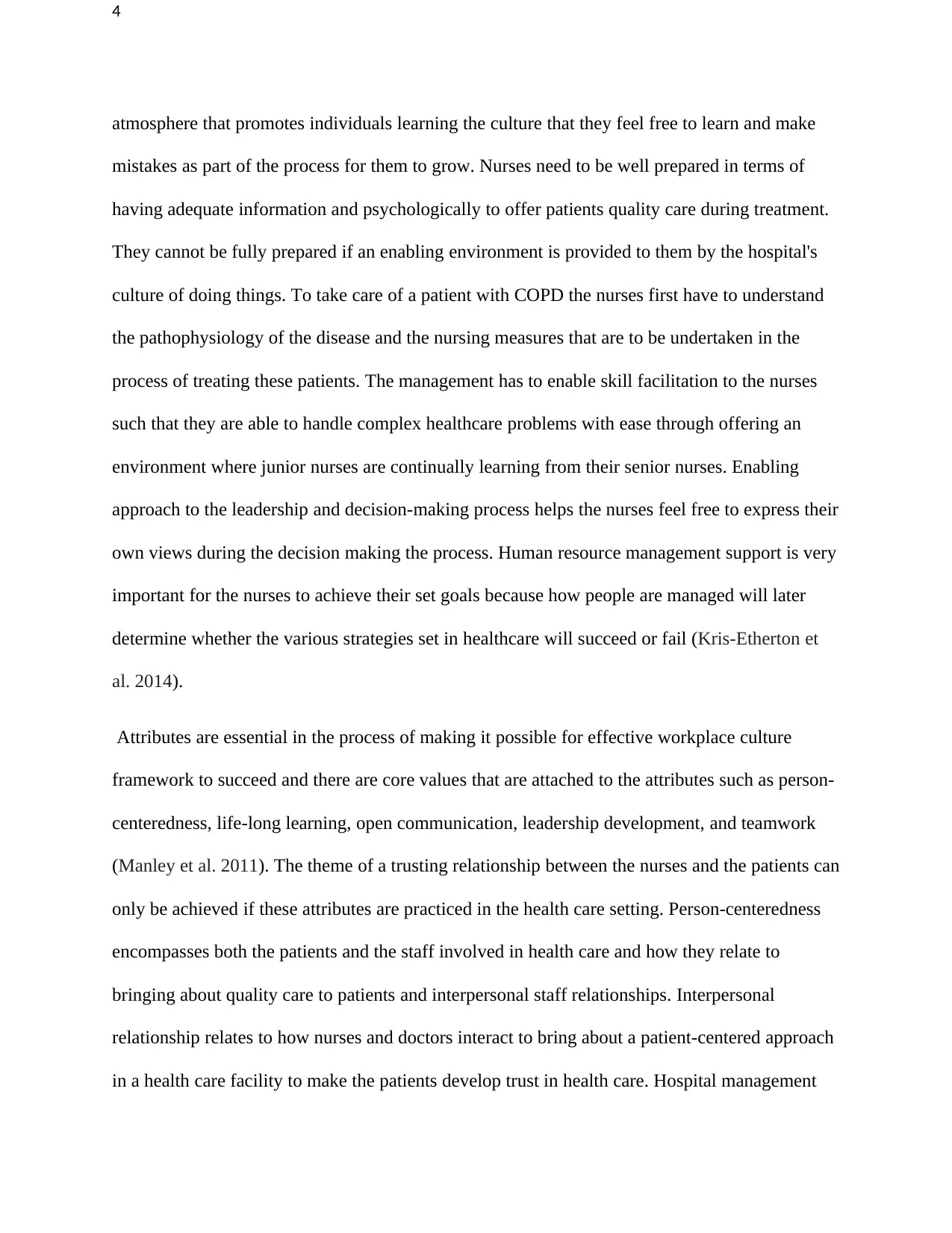
4
atmosphere that promotes individuals learning the culture that they feel free to learn and make
mistakes as part of the process for them to grow. Nurses need to be well prepared in terms of
having adequate information and psychologically to offer patients quality care during treatment.
They cannot be fully prepared if an enabling environment is provided to them by the hospital's
culture of doing things. To take care of a patient with COPD the nurses first have to understand
the pathophysiology of the disease and the nursing measures that are to be undertaken in the
process of treating these patients. The management has to enable skill facilitation to the nurses
such that they are able to handle complex healthcare problems with ease through offering an
environment where junior nurses are continually learning from their senior nurses. Enabling
approach to the leadership and decision-making process helps the nurses feel free to express their
own views during the decision making the process. Human resource management support is very
important for the nurses to achieve their set goals because how people are managed will later
determine whether the various strategies set in healthcare will succeed or fail (Kris-Etherton et
al. 2014).
Attributes are essential in the process of making it possible for effective workplace culture
framework to succeed and there are core values that are attached to the attributes such as person-
centeredness, life-long learning, open communication, leadership development, and teamwork
(Manley et al. 2011). The theme of a trusting relationship between the nurses and the patients can
only be achieved if these attributes are practiced in the health care setting. Person-centeredness
encompasses both the patients and the staff involved in health care and how they relate to
bringing about quality care to patients and interpersonal staff relationships. Interpersonal
relationship relates to how nurses and doctors interact to bring about a patient-centered approach
in a health care facility to make the patients develop trust in health care. Hospital management
atmosphere that promotes individuals learning the culture that they feel free to learn and make
mistakes as part of the process for them to grow. Nurses need to be well prepared in terms of
having adequate information and psychologically to offer patients quality care during treatment.
They cannot be fully prepared if an enabling environment is provided to them by the hospital's
culture of doing things. To take care of a patient with COPD the nurses first have to understand
the pathophysiology of the disease and the nursing measures that are to be undertaken in the
process of treating these patients. The management has to enable skill facilitation to the nurses
such that they are able to handle complex healthcare problems with ease through offering an
environment where junior nurses are continually learning from their senior nurses. Enabling
approach to the leadership and decision-making process helps the nurses feel free to express their
own views during the decision making the process. Human resource management support is very
important for the nurses to achieve their set goals because how people are managed will later
determine whether the various strategies set in healthcare will succeed or fail (Kris-Etherton et
al. 2014).
Attributes are essential in the process of making it possible for effective workplace culture
framework to succeed and there are core values that are attached to the attributes such as person-
centeredness, life-long learning, open communication, leadership development, and teamwork
(Manley et al. 2011). The theme of a trusting relationship between the nurses and the patients can
only be achieved if these attributes are practiced in the health care setting. Person-centeredness
encompasses both the patients and the staff involved in health care and how they relate to
bringing about quality care to patients and interpersonal staff relationships. Interpersonal
relationship relates to how nurses and doctors interact to bring about a patient-centered approach
in a health care facility to make the patients develop trust in health care. Hospital management
Paraphrase This Document
Need a fresh take? Get an instant paraphrase of this document with our AI Paraphraser
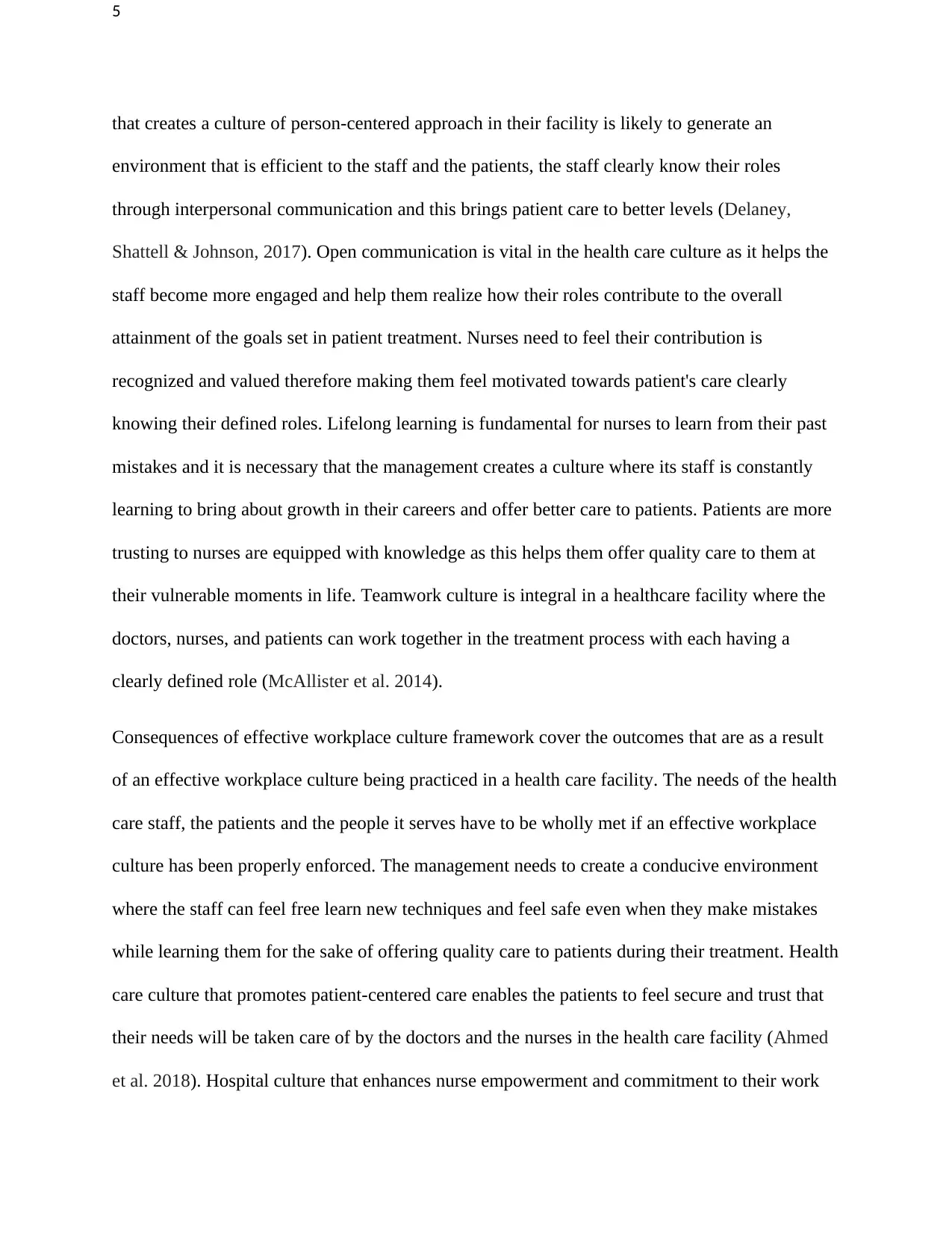
5
that creates a culture of person-centered approach in their facility is likely to generate an
environment that is efficient to the staff and the patients, the staff clearly know their roles
through interpersonal communication and this brings patient care to better levels (Delaney,
Shattell & Johnson, 2017). Open communication is vital in the health care culture as it helps the
staff become more engaged and help them realize how their roles contribute to the overall
attainment of the goals set in patient treatment. Nurses need to feel their contribution is
recognized and valued therefore making them feel motivated towards patient's care clearly
knowing their defined roles. Lifelong learning is fundamental for nurses to learn from their past
mistakes and it is necessary that the management creates a culture where its staff is constantly
learning to bring about growth in their careers and offer better care to patients. Patients are more
trusting to nurses are equipped with knowledge as this helps them offer quality care to them at
their vulnerable moments in life. Teamwork culture is integral in a healthcare facility where the
doctors, nurses, and patients can work together in the treatment process with each having a
clearly defined role (McAllister et al. 2014).
Consequences of effective workplace culture framework cover the outcomes that are as a result
of an effective workplace culture being practiced in a health care facility. The needs of the health
care staff, the patients and the people it serves have to be wholly met if an effective workplace
culture has been properly enforced. The management needs to create a conducive environment
where the staff can feel free learn new techniques and feel safe even when they make mistakes
while learning them for the sake of offering quality care to patients during their treatment. Health
care culture that promotes patient-centered care enables the patients to feel secure and trust that
their needs will be taken care of by the doctors and the nurses in the health care facility (Ahmed
et al. 2018). Hospital culture that enhances nurse empowerment and commitment to their work
that creates a culture of person-centered approach in their facility is likely to generate an
environment that is efficient to the staff and the patients, the staff clearly know their roles
through interpersonal communication and this brings patient care to better levels (Delaney,
Shattell & Johnson, 2017). Open communication is vital in the health care culture as it helps the
staff become more engaged and help them realize how their roles contribute to the overall
attainment of the goals set in patient treatment. Nurses need to feel their contribution is
recognized and valued therefore making them feel motivated towards patient's care clearly
knowing their defined roles. Lifelong learning is fundamental for nurses to learn from their past
mistakes and it is necessary that the management creates a culture where its staff is constantly
learning to bring about growth in their careers and offer better care to patients. Patients are more
trusting to nurses are equipped with knowledge as this helps them offer quality care to them at
their vulnerable moments in life. Teamwork culture is integral in a healthcare facility where the
doctors, nurses, and patients can work together in the treatment process with each having a
clearly defined role (McAllister et al. 2014).
Consequences of effective workplace culture framework cover the outcomes that are as a result
of an effective workplace culture being practiced in a health care facility. The needs of the health
care staff, the patients and the people it serves have to be wholly met if an effective workplace
culture has been properly enforced. The management needs to create a conducive environment
where the staff can feel free learn new techniques and feel safe even when they make mistakes
while learning them for the sake of offering quality care to patients during their treatment. Health
care culture that promotes patient-centered care enables the patients to feel secure and trust that
their needs will be taken care of by the doctors and the nurses in the health care facility (Ahmed
et al. 2018). Hospital culture that enhances nurse empowerment and commitment to their work
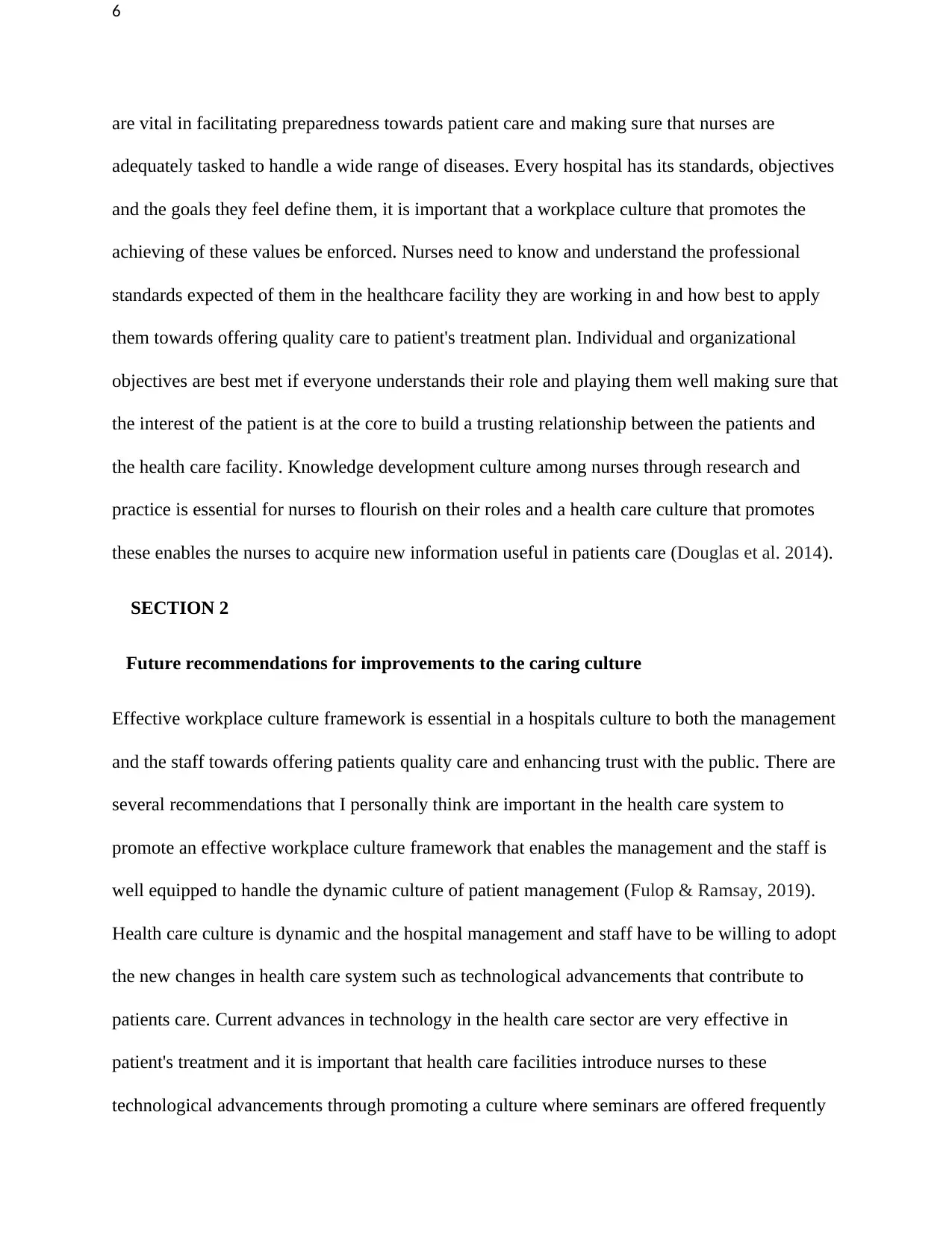
6
are vital in facilitating preparedness towards patient care and making sure that nurses are
adequately tasked to handle a wide range of diseases. Every hospital has its standards, objectives
and the goals they feel define them, it is important that a workplace culture that promotes the
achieving of these values be enforced. Nurses need to know and understand the professional
standards expected of them in the healthcare facility they are working in and how best to apply
them towards offering quality care to patient's treatment plan. Individual and organizational
objectives are best met if everyone understands their role and playing them well making sure that
the interest of the patient is at the core to build a trusting relationship between the patients and
the health care facility. Knowledge development culture among nurses through research and
practice is essential for nurses to flourish on their roles and a health care culture that promotes
these enables the nurses to acquire new information useful in patients care (Douglas et al. 2014).
SECTION 2
Future recommendations for improvements to the caring culture
Effective workplace culture framework is essential in a hospitals culture to both the management
and the staff towards offering patients quality care and enhancing trust with the public. There are
several recommendations that I personally think are important in the health care system to
promote an effective workplace culture framework that enables the management and the staff is
well equipped to handle the dynamic culture of patient management (Fulop & Ramsay, 2019).
Health care culture is dynamic and the hospital management and staff have to be willing to adopt
the new changes in health care system such as technological advancements that contribute to
patients care. Current advances in technology in the health care sector are very effective in
patient's treatment and it is important that health care facilities introduce nurses to these
technological advancements through promoting a culture where seminars are offered frequently
are vital in facilitating preparedness towards patient care and making sure that nurses are
adequately tasked to handle a wide range of diseases. Every hospital has its standards, objectives
and the goals they feel define them, it is important that a workplace culture that promotes the
achieving of these values be enforced. Nurses need to know and understand the professional
standards expected of them in the healthcare facility they are working in and how best to apply
them towards offering quality care to patient's treatment plan. Individual and organizational
objectives are best met if everyone understands their role and playing them well making sure that
the interest of the patient is at the core to build a trusting relationship between the patients and
the health care facility. Knowledge development culture among nurses through research and
practice is essential for nurses to flourish on their roles and a health care culture that promotes
these enables the nurses to acquire new information useful in patients care (Douglas et al. 2014).
SECTION 2
Future recommendations for improvements to the caring culture
Effective workplace culture framework is essential in a hospitals culture to both the management
and the staff towards offering patients quality care and enhancing trust with the public. There are
several recommendations that I personally think are important in the health care system to
promote an effective workplace culture framework that enables the management and the staff is
well equipped to handle the dynamic culture of patient management (Fulop & Ramsay, 2019).
Health care culture is dynamic and the hospital management and staff have to be willing to adopt
the new changes in health care system such as technological advancements that contribute to
patients care. Current advances in technology in the health care sector are very effective in
patient's treatment and it is important that health care facilities introduce nurses to these
technological advancements through promoting a culture where seminars are offered frequently
⊘ This is a preview!⊘
Do you want full access?
Subscribe today to unlock all pages.

Trusted by 1+ million students worldwide
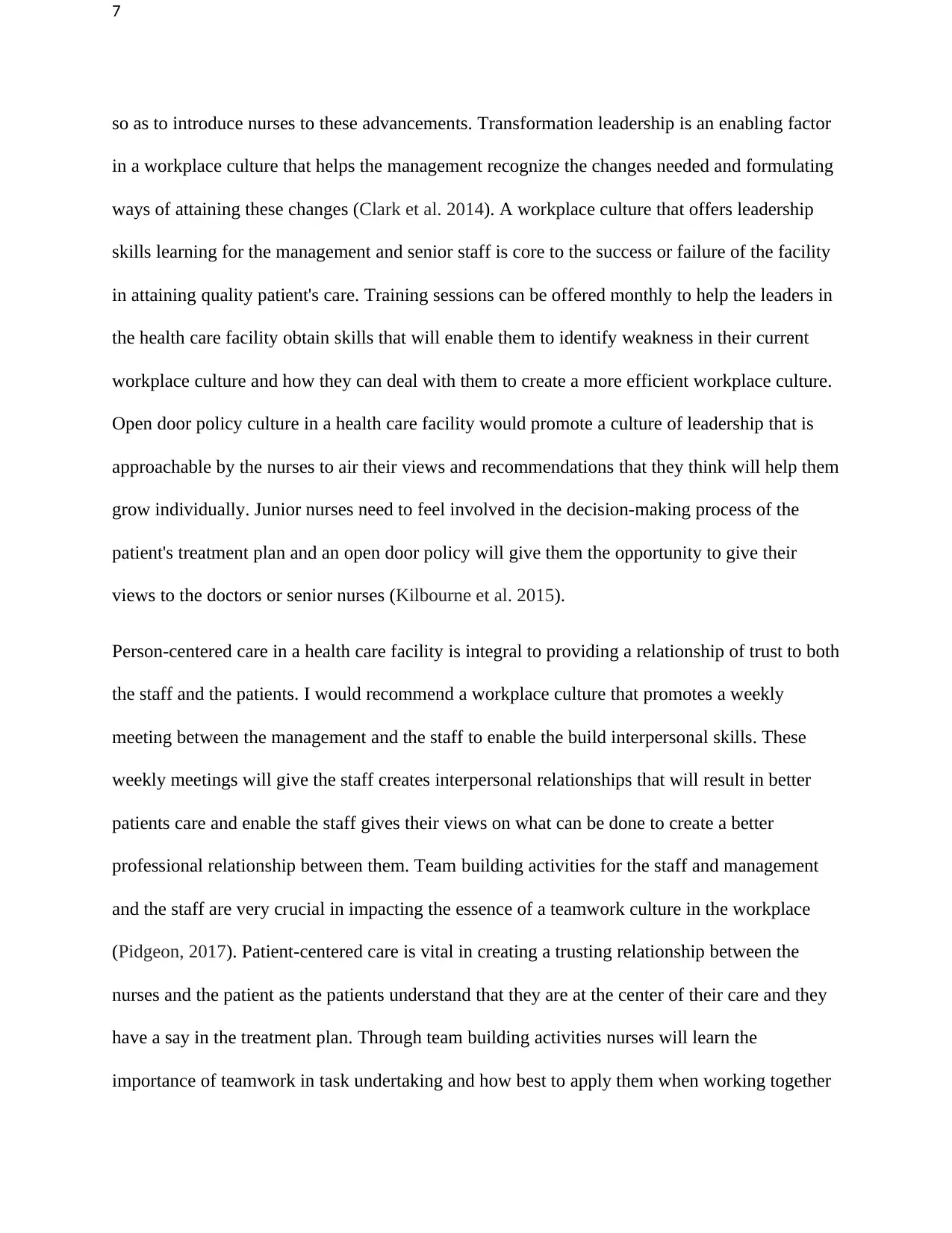
7
so as to introduce nurses to these advancements. Transformation leadership is an enabling factor
in a workplace culture that helps the management recognize the changes needed and formulating
ways of attaining these changes (Clark et al. 2014). A workplace culture that offers leadership
skills learning for the management and senior staff is core to the success or failure of the facility
in attaining quality patient's care. Training sessions can be offered monthly to help the leaders in
the health care facility obtain skills that will enable them to identify weakness in their current
workplace culture and how they can deal with them to create a more efficient workplace culture.
Open door policy culture in a health care facility would promote a culture of leadership that is
approachable by the nurses to air their views and recommendations that they think will help them
grow individually. Junior nurses need to feel involved in the decision-making process of the
patient's treatment plan and an open door policy will give them the opportunity to give their
views to the doctors or senior nurses (Kilbourne et al. 2015).
Person-centered care in a health care facility is integral to providing a relationship of trust to both
the staff and the patients. I would recommend a workplace culture that promotes a weekly
meeting between the management and the staff to enable the build interpersonal skills. These
weekly meetings will give the staff creates interpersonal relationships that will result in better
patients care and enable the staff gives their views on what can be done to create a better
professional relationship between them. Team building activities for the staff and management
and the staff are very crucial in impacting the essence of a teamwork culture in the workplace
(Pidgeon, 2017). Patient-centered care is vital in creating a trusting relationship between the
nurses and the patient as the patients understand that they are at the center of their care and they
have a say in the treatment plan. Through team building activities nurses will learn the
importance of teamwork in task undertaking and how best to apply them when working together
so as to introduce nurses to these advancements. Transformation leadership is an enabling factor
in a workplace culture that helps the management recognize the changes needed and formulating
ways of attaining these changes (Clark et al. 2014). A workplace culture that offers leadership
skills learning for the management and senior staff is core to the success or failure of the facility
in attaining quality patient's care. Training sessions can be offered monthly to help the leaders in
the health care facility obtain skills that will enable them to identify weakness in their current
workplace culture and how they can deal with them to create a more efficient workplace culture.
Open door policy culture in a health care facility would promote a culture of leadership that is
approachable by the nurses to air their views and recommendations that they think will help them
grow individually. Junior nurses need to feel involved in the decision-making process of the
patient's treatment plan and an open door policy will give them the opportunity to give their
views to the doctors or senior nurses (Kilbourne et al. 2015).
Person-centered care in a health care facility is integral to providing a relationship of trust to both
the staff and the patients. I would recommend a workplace culture that promotes a weekly
meeting between the management and the staff to enable the build interpersonal skills. These
weekly meetings will give the staff creates interpersonal relationships that will result in better
patients care and enable the staff gives their views on what can be done to create a better
professional relationship between them. Team building activities for the staff and management
and the staff are very crucial in impacting the essence of a teamwork culture in the workplace
(Pidgeon, 2017). Patient-centered care is vital in creating a trusting relationship between the
nurses and the patient as the patients understand that they are at the center of their care and they
have a say in the treatment plan. Through team building activities nurses will learn the
importance of teamwork in task undertaking and how best to apply them when working together
Paraphrase This Document
Need a fresh take? Get an instant paraphrase of this document with our AI Paraphraser
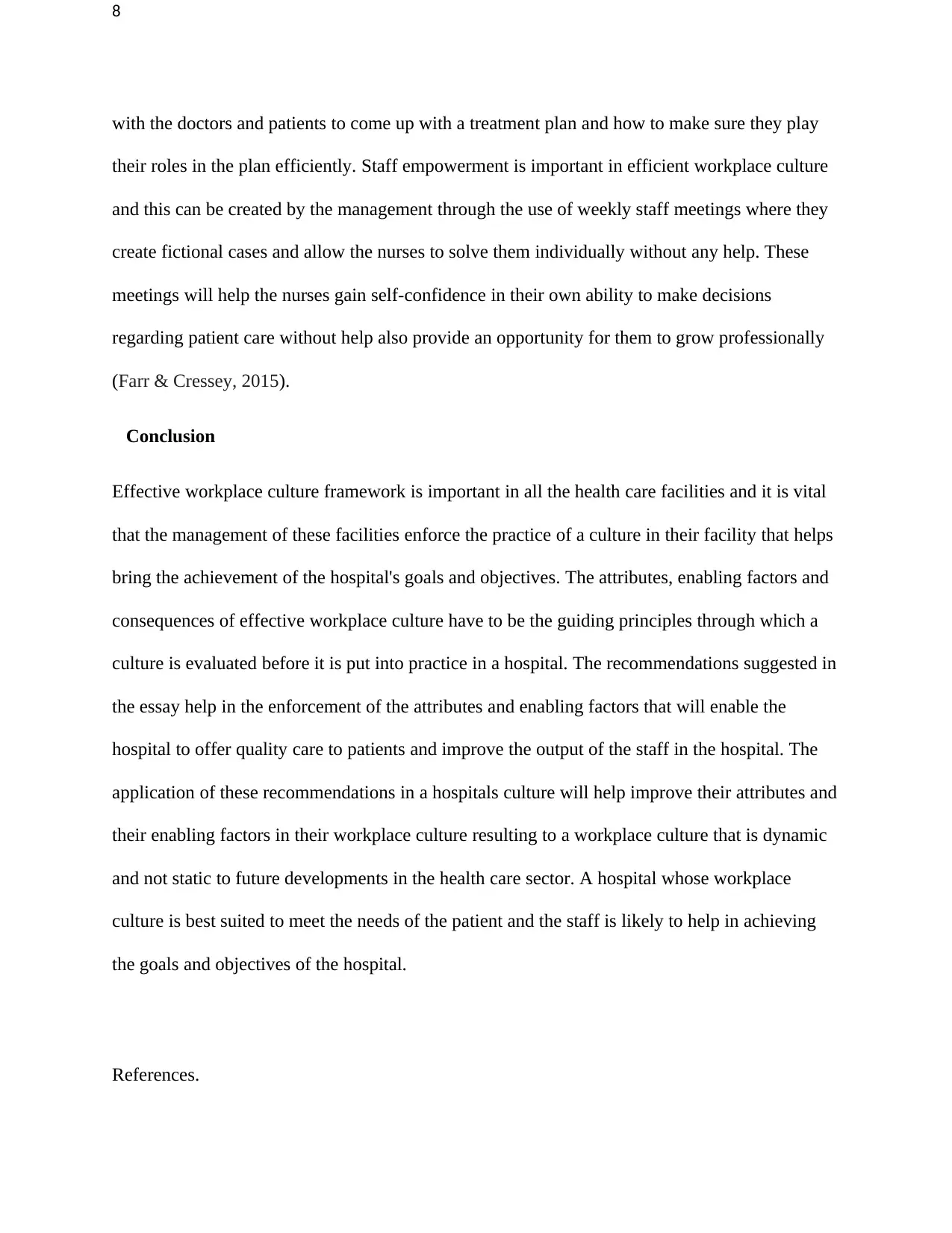
8
with the doctors and patients to come up with a treatment plan and how to make sure they play
their roles in the plan efficiently. Staff empowerment is important in efficient workplace culture
and this can be created by the management through the use of weekly staff meetings where they
create fictional cases and allow the nurses to solve them individually without any help. These
meetings will help the nurses gain self-confidence in their own ability to make decisions
regarding patient care without help also provide an opportunity for them to grow professionally
(Farr & Cressey, 2015).
Conclusion
Effective workplace culture framework is important in all the health care facilities and it is vital
that the management of these facilities enforce the practice of a culture in their facility that helps
bring the achievement of the hospital's goals and objectives. The attributes, enabling factors and
consequences of effective workplace culture have to be the guiding principles through which a
culture is evaluated before it is put into practice in a hospital. The recommendations suggested in
the essay help in the enforcement of the attributes and enabling factors that will enable the
hospital to offer quality care to patients and improve the output of the staff in the hospital. The
application of these recommendations in a hospitals culture will help improve their attributes and
their enabling factors in their workplace culture resulting to a workplace culture that is dynamic
and not static to future developments in the health care sector. A hospital whose workplace
culture is best suited to meet the needs of the patient and the staff is likely to help in achieving
the goals and objectives of the hospital.
References.
with the doctors and patients to come up with a treatment plan and how to make sure they play
their roles in the plan efficiently. Staff empowerment is important in efficient workplace culture
and this can be created by the management through the use of weekly staff meetings where they
create fictional cases and allow the nurses to solve them individually without any help. These
meetings will help the nurses gain self-confidence in their own ability to make decisions
regarding patient care without help also provide an opportunity for them to grow professionally
(Farr & Cressey, 2015).
Conclusion
Effective workplace culture framework is important in all the health care facilities and it is vital
that the management of these facilities enforce the practice of a culture in their facility that helps
bring the achievement of the hospital's goals and objectives. The attributes, enabling factors and
consequences of effective workplace culture have to be the guiding principles through which a
culture is evaluated before it is put into practice in a hospital. The recommendations suggested in
the essay help in the enforcement of the attributes and enabling factors that will enable the
hospital to offer quality care to patients and improve the output of the staff in the hospital. The
application of these recommendations in a hospitals culture will help improve their attributes and
their enabling factors in their workplace culture resulting to a workplace culture that is dynamic
and not static to future developments in the health care sector. A hospital whose workplace
culture is best suited to meet the needs of the patient and the staff is likely to help in achieving
the goals and objectives of the hospital.
References.
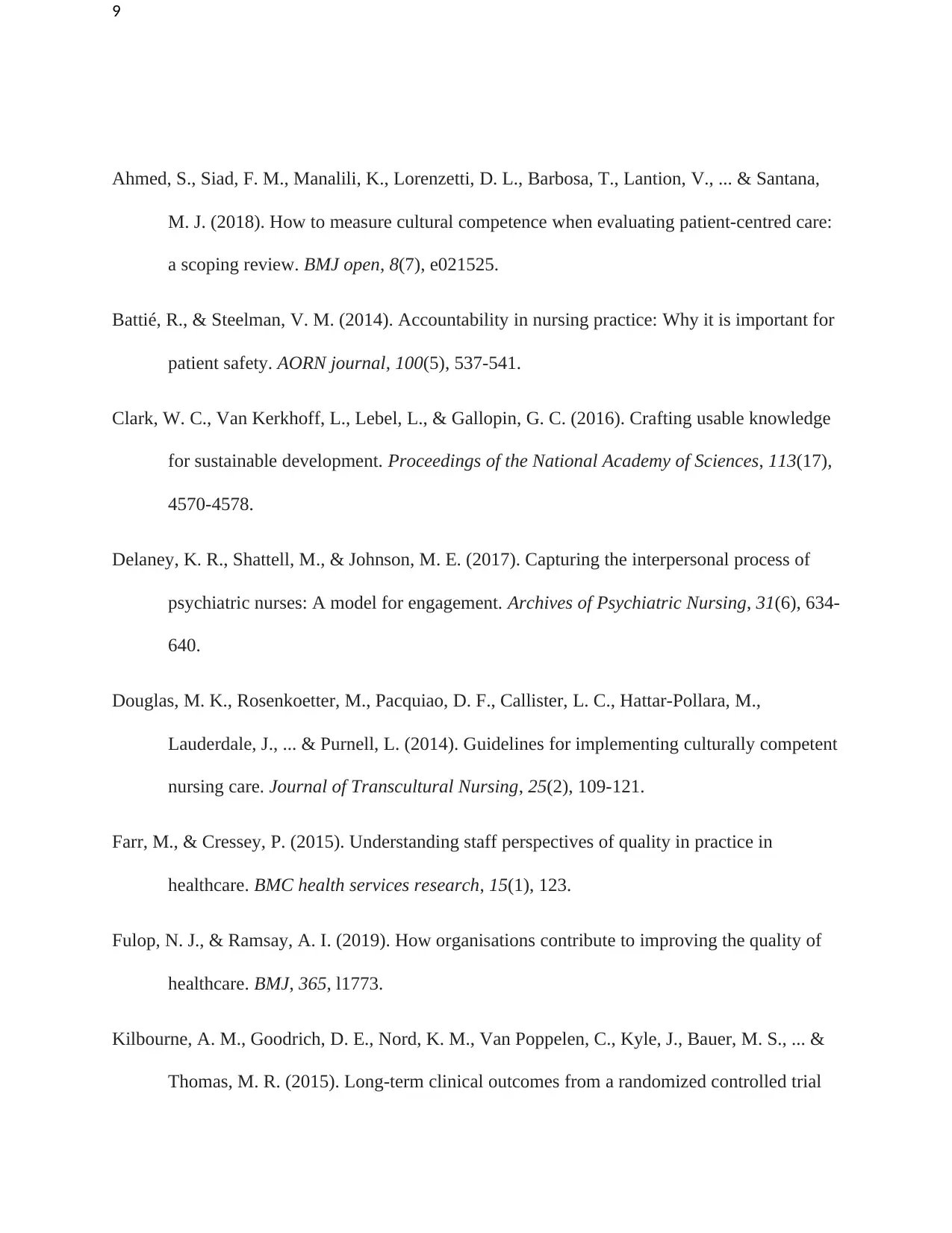
9
Ahmed, S., Siad, F. M., Manalili, K., Lorenzetti, D. L., Barbosa, T., Lantion, V., ... & Santana,
M. J. (2018). How to measure cultural competence when evaluating patient-centred care:
a scoping review. BMJ open, 8(7), e021525.
Battié, R., & Steelman, V. M. (2014). Accountability in nursing practice: Why it is important for
patient safety. AORN journal, 100(5), 537-541.
Clark, W. C., Van Kerkhoff, L., Lebel, L., & Gallopin, G. C. (2016). Crafting usable knowledge
for sustainable development. Proceedings of the National Academy of Sciences, 113(17),
4570-4578.
Delaney, K. R., Shattell, M., & Johnson, M. E. (2017). Capturing the interpersonal process of
psychiatric nurses: A model for engagement. Archives of Psychiatric Nursing, 31(6), 634-
640.
Douglas, M. K., Rosenkoetter, M., Pacquiao, D. F., Callister, L. C., Hattar-Pollara, M.,
Lauderdale, J., ... & Purnell, L. (2014). Guidelines for implementing culturally competent
nursing care. Journal of Transcultural Nursing, 25(2), 109-121.
Farr, M., & Cressey, P. (2015). Understanding staff perspectives of quality in practice in
healthcare. BMC health services research, 15(1), 123.
Fulop, N. J., & Ramsay, A. I. (2019). How organisations contribute to improving the quality of
healthcare. BMJ, 365, l1773.
Kilbourne, A. M., Goodrich, D. E., Nord, K. M., Van Poppelen, C., Kyle, J., Bauer, M. S., ... &
Thomas, M. R. (2015). Long-term clinical outcomes from a randomized controlled trial
Ahmed, S., Siad, F. M., Manalili, K., Lorenzetti, D. L., Barbosa, T., Lantion, V., ... & Santana,
M. J. (2018). How to measure cultural competence when evaluating patient-centred care:
a scoping review. BMJ open, 8(7), e021525.
Battié, R., & Steelman, V. M. (2014). Accountability in nursing practice: Why it is important for
patient safety. AORN journal, 100(5), 537-541.
Clark, W. C., Van Kerkhoff, L., Lebel, L., & Gallopin, G. C. (2016). Crafting usable knowledge
for sustainable development. Proceedings of the National Academy of Sciences, 113(17),
4570-4578.
Delaney, K. R., Shattell, M., & Johnson, M. E. (2017). Capturing the interpersonal process of
psychiatric nurses: A model for engagement. Archives of Psychiatric Nursing, 31(6), 634-
640.
Douglas, M. K., Rosenkoetter, M., Pacquiao, D. F., Callister, L. C., Hattar-Pollara, M.,
Lauderdale, J., ... & Purnell, L. (2014). Guidelines for implementing culturally competent
nursing care. Journal of Transcultural Nursing, 25(2), 109-121.
Farr, M., & Cressey, P. (2015). Understanding staff perspectives of quality in practice in
healthcare. BMC health services research, 15(1), 123.
Fulop, N. J., & Ramsay, A. I. (2019). How organisations contribute to improving the quality of
healthcare. BMJ, 365, l1773.
Kilbourne, A. M., Goodrich, D. E., Nord, K. M., Van Poppelen, C., Kyle, J., Bauer, M. S., ... &
Thomas, M. R. (2015). Long-term clinical outcomes from a randomized controlled trial
⊘ This is a preview!⊘
Do you want full access?
Subscribe today to unlock all pages.

Trusted by 1+ million students worldwide
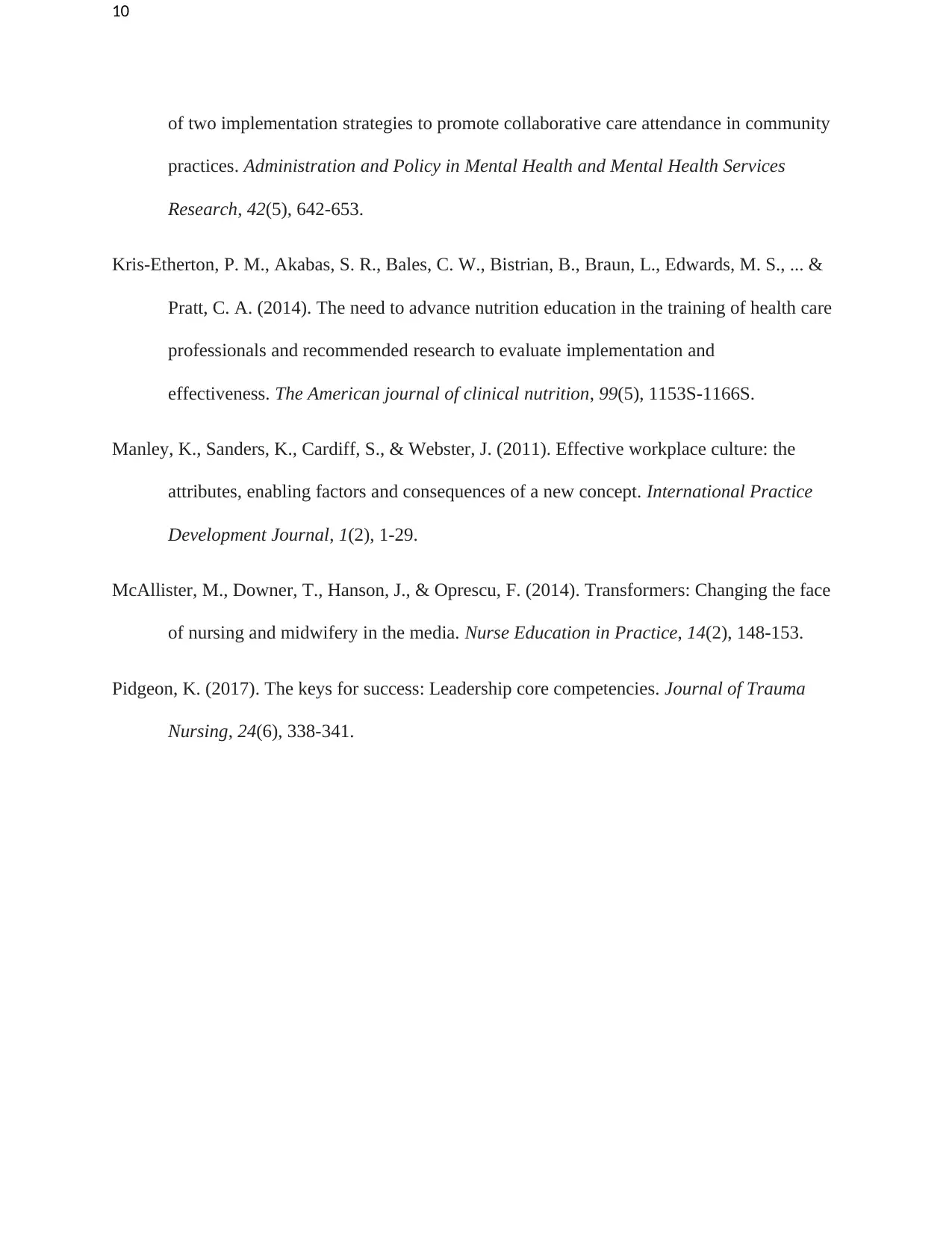
10
of two implementation strategies to promote collaborative care attendance in community
practices. Administration and Policy in Mental Health and Mental Health Services
Research, 42(5), 642-653.
Kris-Etherton, P. M., Akabas, S. R., Bales, C. W., Bistrian, B., Braun, L., Edwards, M. S., ... &
Pratt, C. A. (2014). The need to advance nutrition education in the training of health care
professionals and recommended research to evaluate implementation and
effectiveness. The American journal of clinical nutrition, 99(5), 1153S-1166S.
Manley, K., Sanders, K., Cardiff, S., & Webster, J. (2011). Effective workplace culture: the
attributes, enabling factors and consequences of a new concept. International Practice
Development Journal, 1(2), 1-29.
McAllister, M., Downer, T., Hanson, J., & Oprescu, F. (2014). Transformers: Changing the face
of nursing and midwifery in the media. Nurse Education in Practice, 14(2), 148-153.
Pidgeon, K. (2017). The keys for success: Leadership core competencies. Journal of Trauma
Nursing, 24(6), 338-341.
of two implementation strategies to promote collaborative care attendance in community
practices. Administration and Policy in Mental Health and Mental Health Services
Research, 42(5), 642-653.
Kris-Etherton, P. M., Akabas, S. R., Bales, C. W., Bistrian, B., Braun, L., Edwards, M. S., ... &
Pratt, C. A. (2014). The need to advance nutrition education in the training of health care
professionals and recommended research to evaluate implementation and
effectiveness. The American journal of clinical nutrition, 99(5), 1153S-1166S.
Manley, K., Sanders, K., Cardiff, S., & Webster, J. (2011). Effective workplace culture: the
attributes, enabling factors and consequences of a new concept. International Practice
Development Journal, 1(2), 1-29.
McAllister, M., Downer, T., Hanson, J., & Oprescu, F. (2014). Transformers: Changing the face
of nursing and midwifery in the media. Nurse Education in Practice, 14(2), 148-153.
Pidgeon, K. (2017). The keys for success: Leadership core competencies. Journal of Trauma
Nursing, 24(6), 338-341.
1 out of 10
Related Documents
Your All-in-One AI-Powered Toolkit for Academic Success.
+13062052269
info@desklib.com
Available 24*7 on WhatsApp / Email
![[object Object]](/_next/static/media/star-bottom.7253800d.svg)
Unlock your academic potential
Copyright © 2020–2025 A2Z Services. All Rights Reserved. Developed and managed by ZUCOL.





